Zhefeng Wang
FASP: Fast and Accurate Structured Pruning of Large Language Models
Jan 16, 2025



Abstract:The rapid increase in the size of large language models (LLMs) has significantly escalated their computational and memory demands, posing challenges for efficient deployment, especially on resource-constrained devices. Structured pruning has emerged as an effective model compression method that can reduce these demands while preserving performance. In this paper, we introduce FASP (Fast and Accurate Structured Pruning), a novel structured pruning framework for LLMs that emphasizes both speed and accuracy. FASP employs a distinctive pruning structure that interlinks sequential layers, allowing for the removal of columns in one layer while simultaneously eliminating corresponding rows in the preceding layer without incurring additional performance loss. The pruning metric, inspired by Wanda, is computationally efficient and effectively selects components to prune. Additionally, we propose a restoration mechanism that enhances model fidelity by adjusting the remaining weights post-pruning. We evaluate FASP on the OPT and LLaMA model families, demonstrating superior performance in terms of perplexity and accuracy on downstream tasks compared to state-of-the-art methods. Our approach achieves significant speed-ups, pruning models such as OPT-125M in 17 seconds and LLaMA-30B in 15 minutes on a single NVIDIA RTX 4090 GPU, making it a highly practical solution for optimizing LLMs.
Beware of Calibration Data for Pruning Large Language Models
Oct 23, 2024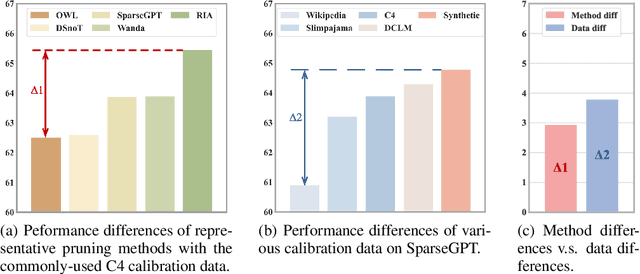

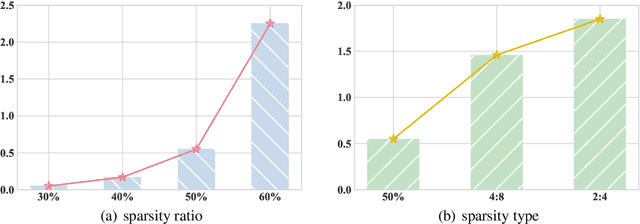

Abstract:As large language models (LLMs) are widely applied across various fields, model compression has become increasingly crucial for reducing costs and improving inference efficiency. Post-training pruning is a promising method that does not require resource-intensive iterative training and only needs a small amount of calibration data to assess the importance of parameters. Previous research has primarily focused on designing advanced pruning methods, while different calibration data's impact on pruning performance still lacks systematical exploration. We fill this blank and surprisingly observe that the effects of calibration data even value more than designing advanced pruning strategies, especially for high sparsity. Our preliminary exploration also discloses that using calibration data similar to the training data can yield better performance. As pre-training data is usually inaccessible for advanced LLMs, we further provide a self-generating calibration data synthesis strategy to construct feasible calibration data. We conduct experiments on the recent strong open-source LLMs (e.g., DCLM, and LLaMA-3), and the results show that the proposed method outperforms commonly used calibration data and can effectively enhance strong pruning methods (e.g., Wanda, OWL).
A Convex-optimization-based Layer-wise Post-training Pruner for Large Language Models
Aug 07, 2024



Abstract:Pruning is a critical strategy for compressing trained large language models (LLMs), aiming at substantial memory conservation and computational acceleration without compromising performance. However, existing pruning methods often necessitate inefficient retraining for billion-scale LLMs or rely on heuristic methods such as the optimal brain surgeon framework, which degrade performance. In this paper, we introduce FISTAPruner, the first post-training pruner based on convex optimization models and algorithms. Specifically, we propose a convex optimization model incorporating $\ell_1$ norm to induce sparsity and utilize the FISTA solver for optimization. FISTAPruner incorporates an intra-layer cumulative error correction mechanism and supports parallel pruning. We comprehensively evaluate FISTAPruner on models such as OPT, LLaMA, LLaMA-2, and LLaMA-3 with 125M to 70B parameters under unstructured and 2:4 semi-structured sparsity, demonstrating superior performance over existing state-of-the-art methods across various language benchmarks.
MSceneSpeech: A Multi-Scene Speech Dataset For Expressive Speech Synthesis
Jul 19, 2024



Abstract:We introduce an open source high-quality Mandarin TTS dataset MSceneSpeech (Multiple Scene Speech Dataset), which is intended to provide resources for expressive speech synthesis. MSceneSpeech comprises numerous audio recordings and texts performed and recorded according to daily life scenarios. Each scenario includes multiple speakers and a diverse range of prosodic styles, making it suitable for speech synthesis that entails multi-speaker style and prosody modeling. We have established a robust baseline, through the prompting mechanism, that can effectively synthesize speech characterized by both user-specific timbre and scene-specific prosody with arbitrary text input. The open source MSceneSpeech Dataset and audio samples of our baseline are available at https://speechai-demo.github.io/MSceneSpeech/.
OPT-Tree: Speculative Decoding with Adaptive Draft Tree Structure
Jun 25, 2024Abstract:Autoregressive language models demonstrate excellent performance in various scenarios. However, the inference efficiency is limited by its one-step-one-word generation mode, which has become a pressing problem recently as the models become increasingly larger. Speculative decoding employs a "draft and then verify" mechanism to allow multiple tokens to be generated in one step, realizing lossless acceleration. Existing methods mainly adopt fixed heuristic draft structures, which fail to adapt to different situations to maximize the acceptance length during verification. To alleviate this dilemma, we proposed OPT-Tree, an algorithm to construct adaptive and scalable draft trees. It searches the optimal tree structure that maximizes the mathematical expectation of the acceptance length in each decoding step. Experimental results reveal that OPT-Tree outperforms the existing draft structures and achieves a speed-up ratio of up to 3.2 compared with autoregressive decoding. If the draft model is powerful enough and the node budget is sufficient, it can generate more than ten tokens in a single step. Our code is available at https://github.com/Jikai0Wang/OPT-Tree.
Optimizing Large Model Training through Overlapped Activation Recomputation
Jun 13, 2024Abstract:Large model training has been using recomputation to alleviate the memory pressure and pipelining to exploit the parallelism of data, tensor, and devices. The existing recomputation approaches may incur up to 40% overhead when training real-world models, e.g., the GPT model with 22B parameters. This is because they are executed on demand in the critical training path. In this paper, we design a new recomputation framework, Lynx, to reduce the overhead by overlapping the recomputation with communication occurring in training pipelines. It consists of an optimal scheduling algorithm (OPT) and a heuristic-based scheduling algorithm (HEU). OPT achieves a global optimum but suffers from a long search time. HEU was designed based on our observation that there are identical structures in large DNN models so that we can apply the same scheduling policy to all identical structures. HEU achieves a local optimum but reduces the search time by 99% compared to OPT. Our comprehensive evaluation using GPT models with 1.3B-20B parameters shows that both OPT and HEU outperform the state-of-the-art recomputation approaches (e.g., Megatron-LM and Checkmake) by 1.02-1.53x. HEU achieves a similar performance as OPT with a search time of 0.16s on average.
Adapprox: Adaptive Approximation in Adam Optimization via Randomized Low-Rank Matrices
Mar 22, 2024Abstract:As deep learning models exponentially increase in size, optimizers such as Adam encounter significant memory consumption challenges due to the storage of first and second moment data. Current memory-efficient methods like Adafactor and CAME often compromise accuracy with their matrix factorization techniques. Addressing this, we introduce Adapprox, a novel approach that employs randomized low-rank matrix approximation for a more effective and accurate approximation of Adam's second moment. Adapprox features an adaptive rank selection mechanism, finely balancing accuracy and memory efficiency, and includes an optional cosine similarity guidance strategy to enhance stability and expedite convergence. In GPT-2 training and downstream tasks, Adapprox surpasses AdamW by achieving 34.5% to 49.9% and 33.8% to 49.9% memory savings for the 117M and 345M models, respectively, with the first moment enabled, and further increases these savings without the first moment. Besides, it enhances convergence speed and improves downstream task performance relative to its counterparts.
A General and Flexible Multi-concept Parsing Framework for Multilingual Semantic Matching
Mar 05, 2024



Abstract:Sentence semantic matching is a research hotspot in natural language processing, which is considerably significant in various key scenarios, such as community question answering, searching, chatbot, and recommendation. Since most of the advanced models directly model the semantic relevance among words between two sentences while neglecting the \textit{keywords} and \textit{intents} concepts of them, DC-Match is proposed to disentangle keywords from intents and utilizes them to optimize the matching performance. Although DC-Match is a simple yet effective method for semantic matching, it highly depends on the external NER techniques to identify the keywords of sentences, which limits the performance of semantic matching for minor languages since satisfactory NER tools are usually hard to obtain. In this paper, we propose to generally and flexibly resolve the text into multi concepts for multilingual semantic matching to liberate the model from the reliance on NER models. To this end, we devise a \underline{M}ulti-\underline{C}oncept \underline{P}arsed \underline{S}emantic \underline{M}atching framework based on the pre-trained language models, abbreviated as \textbf{MCP-SM}, to extract various concepts and infuse them into the classification tokens. We conduct comprehensive experiments on English datasets QQP and MRPC, and Chinese dataset Medical-SM. Besides, we experiment on Arabic datasets MQ2Q and XNLI, the outstanding performance further prove MCP-SM's applicability in low-resource languages.
Shai: A large language model for asset management
Dec 21, 2023Abstract:This paper introduces "Shai" a 10B level large language model specifically designed for the asset management industry, built upon an open-source foundational model. With continuous pre-training and fine-tuning using a targeted corpus, Shai demonstrates enhanced performance in tasks relevant to its domain, outperforming baseline models. Our research includes the development of an innovative evaluation framework, which integrates professional qualification exams, tailored tasks, open-ended question answering, and safety assessments, to comprehensively assess Shai's capabilities. Furthermore, we discuss the challenges and implications of utilizing large language models like GPT-4 for performance assessment in asset management, suggesting a combination of automated evaluation and human judgment. Shai's development, showcasing the potential and versatility of 10B-level large language models in the financial sector with significant performance and modest computational requirements, hopes to provide practical insights and methodologies to assist industry peers in their similar endeavors.
Mirror: A Universal Framework for Various Information Extraction Tasks
Nov 26, 2023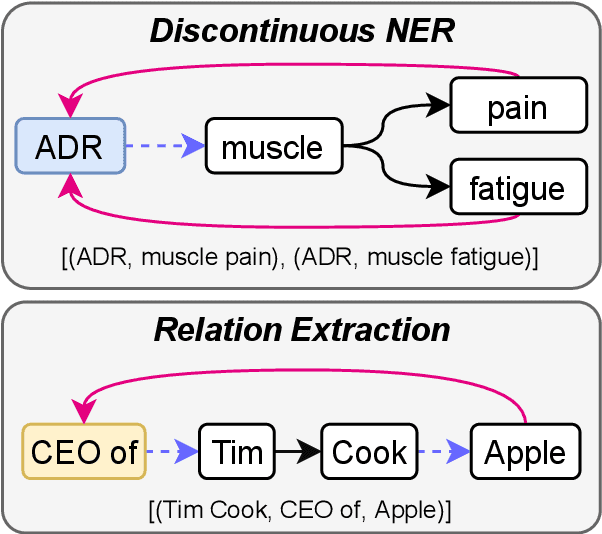
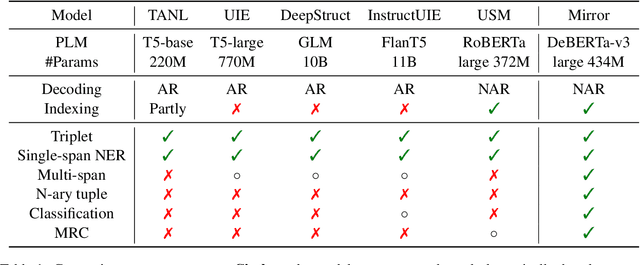
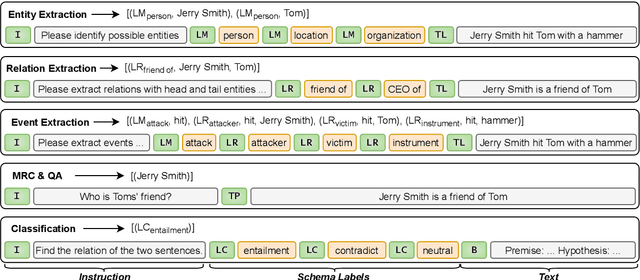
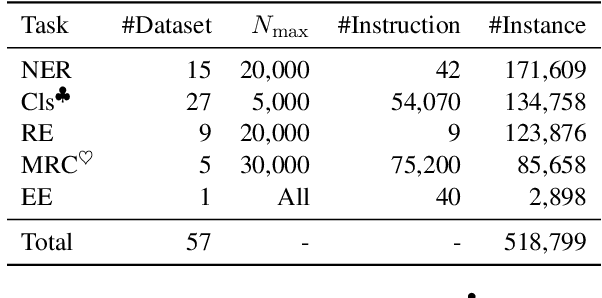
Abstract:Sharing knowledge between information extraction tasks has always been a challenge due to the diverse data formats and task variations. Meanwhile, this divergence leads to information waste and increases difficulties in building complex applications in real scenarios. Recent studies often formulate IE tasks as a triplet extraction problem. However, such a paradigm does not support multi-span and n-ary extraction, leading to weak versatility. To this end, we reorganize IE problems into unified multi-slot tuples and propose a universal framework for various IE tasks, namely Mirror. Specifically, we recast existing IE tasks as a multi-span cyclic graph extraction problem and devise a non-autoregressive graph decoding algorithm to extract all spans in a single step. It is worth noting that this graph structure is incredibly versatile, and it supports not only complex IE tasks, but also machine reading comprehension and classification tasks. We manually construct a corpus containing 57 datasets for model pretraining, and conduct experiments on 30 datasets across 8 downstream tasks. The experimental results demonstrate that our model has decent compatibility and outperforms or reaches competitive performance with SOTA systems under few-shot and zero-shot settings. The code, model weights, and pretraining corpus are available at https://github.com/Spico197/Mirror .
 Add to Chrome
Add to Chrome Add to Firefox
Add to Firefox Add to Edge
Add to Edge